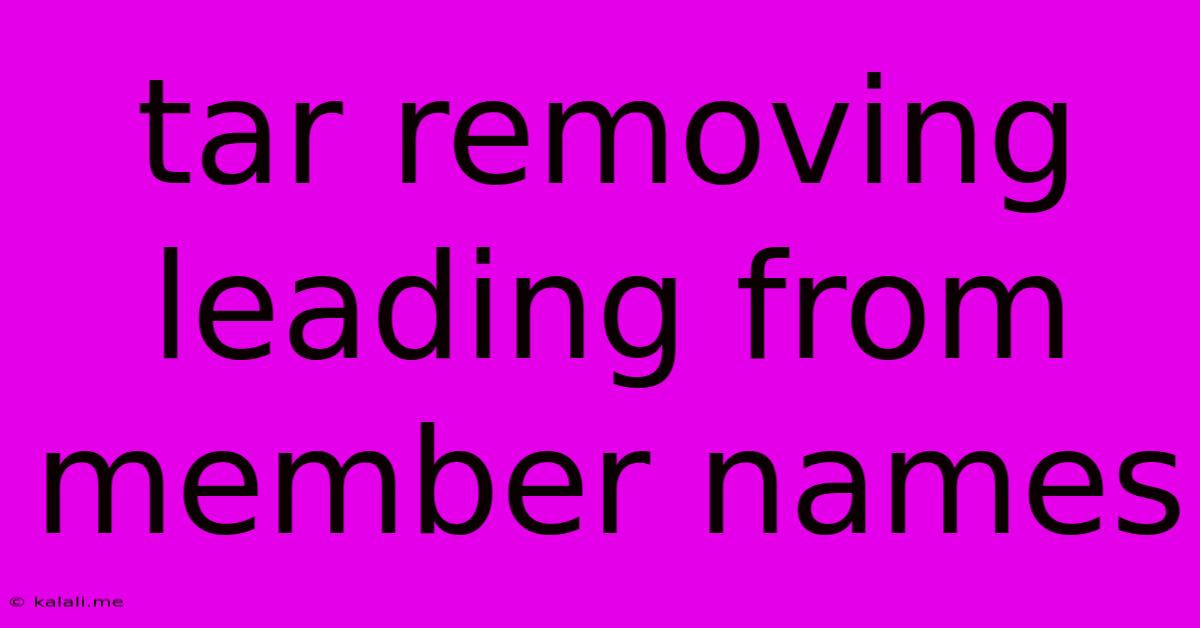Tar: Removing Leading '/' From Member Names
Kalali
May 29, 2025 · 3 min read

Table of Contents
Tar: Removing Leading '/' from Member Names
This article tackles a common issue encountered when working with the tar command: dealing with archive members whose names begin with a leading forward slash (/). These leading slashes can cause problems when extracting the archive, potentially creating files in the root directory of your system, which is a significant security risk. This guide explains how to safely remove these leading slashes during the extraction process, ensuring your files are extracted to the intended location.
Understanding the Problem:
A leading / in a filename within a tar archive signifies an absolute path. When extracting an archive containing such files, tar will attempt to create these files at the specified absolute path, potentially overwriting important system files if the path starts at the root directory (/). This is a serious security concern and should be avoided.
Methods for Removing Leading Slashes:
There are several ways to handle this situation, each with its own advantages and disadvantages.
1. Using tar's --transform option (Recommended):
This is generally the most efficient and straightforward method, particularly for large archives. The --transform option allows you to perform substitutions on filenames during extraction. We can use a regular expression to remove the leading slash.
tar -xf archive.tar --transform 's|^/||'
-x: Extract files.-f: Specify the archive file.--transform 's|^/||': This is the key part. It usessed-like substitution.s|^/||means:s: Substitute.|^/|: Match a leading/. The^anchors the match to the beginning of the string.||: Replace the matched/with nothing (effectively removing it).
This command extracts all files from archive.tar, removing the leading / from any filenames that have it.
2. Using tar with --strip-components (For Specific Directories):
If the leading / consistently indicates a specific top-level directory within the archive, you can use --strip-components to remove that directory layer. This is less flexible than --transform but might be preferable if you understand the archive's structure.
For example, if all problematic files are within a directory named /mydirectory/ inside the archive:
tar -xf archive.tar --strip-components=1
This command will remove the first directory component (/mydirectory/ in this example) from each extracted file's path. Adjust 1 to the correct number of components to strip if needed. Use caution with this option; incorrect use could lead to unexpected results.
3. Pre-processing the Archive (Less Recommended):
While possible, manually modifying the archive contents before extraction is generally less efficient and potentially more error-prone, especially for large archives. This might involve using tools like sed or awk to process the tar file's contents, which requires a good understanding of the tar file format. We strongly advise against this method unless you have a very specific reason and advanced tar knowledge.
Choosing the Right Method:
The --transform option is generally the recommended approach due to its flexibility, safety, and ease of use. It handles various filename structures without requiring prior knowledge of the archive's internal layout. The --strip-components option provides a simpler alternative if the leading / consistently represents a predictable directory structure within the archive. Avoid manually pre-processing the archive unless absolutely necessary.
Security Considerations:
Remember that extracting archives containing files with absolute paths is a potential security risk. Always inspect archive contents and understand their source before extraction. Always use a method that prevents accidental modification or overwriting of system files.
By implementing these techniques, you can safely and efficiently extract tar archives, regardless of leading slashes in filenames, preventing potential security issues and ensuring a smooth workflow.
Latest Posts
Latest Posts
-
Why Doesnt Christian Bale Remove His Mole
Jul 02, 2025
-
Somebody Once Told Me That The World Was Macaroni Lyrics
Jul 02, 2025
-
How Old Are You If Born In 1993
Jul 02, 2025
-
What Is 1 4 Of 1 4 Cup
Jul 02, 2025
-
Is Keri Russell Related To Kurt Russell
Jul 02, 2025
Related Post
Thank you for visiting our website which covers about Tar: Removing Leading '/' From Member Names . We hope the information provided has been useful to you. Feel free to contact us if you have any questions or need further assistance. See you next time and don't miss to bookmark.